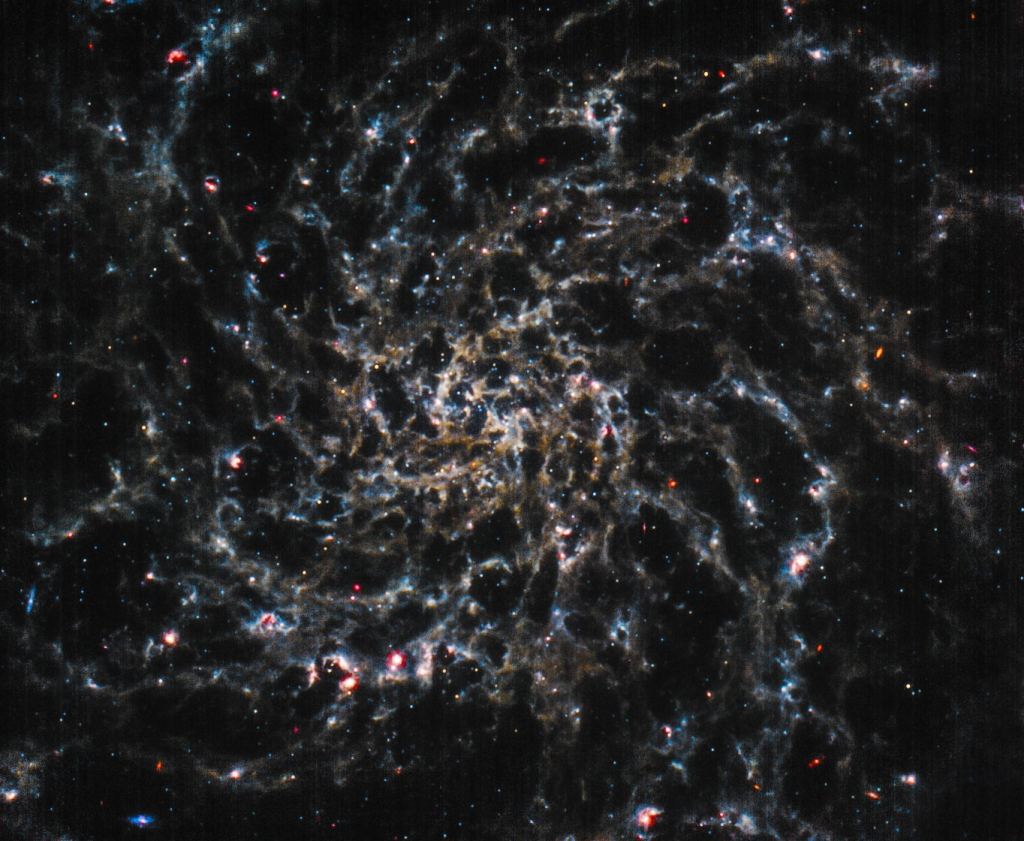The James Webb Space Telescope (JWST) continues to both dazzle and amaze with its latest image, this time of Galaxy IC 5332, also known as PGC 71775, which is an intermediate spiral galaxy located approximately 30 million light years away. This comes after JWST released its first images at its full power, which includes the Carina Nebula, Stephan’s Quintet, Southern Ring Nebula, and SMACS 0723, the last of which was the deepest and sharpest image of the distant universe to date. This most recent image of IC 5332 was processed by expert space image processor, Judy Schmidt, and can be seen on her Flickr page and website.
She also shows a combination of IC 5332 in visible and infrared on her Twitter page, as well. Originally from New York City, Schmidt currently lives in Modesto, CA, according to her website. Dust lanes of IC5332.
(Credit: NASA / ESA / CSA / Judy Schmidt) The original idea for JSWT was proposed at the Next Generation Space Telescope Workshop at the Space Telescope Science Institute in 1989 and was officially renamed the James Webb Space Telescope in 2002, with construction officially starting in 2004. Given JWST’s size and complexity, it spent the better part of the next two decades undergoing construction and rigorous tests to ensure everything functioned properly. JWST finally launched on Christmas Day 2021 on an Ariane 5 rocket from Kourou, French Guinea, arriving at the Sun-Earth L2 Lagrange point in January 2022.
Lagrange points are gravitationally stable regions of space where objects can remain almost indefinitely with far less fuel required to keep them there. The Sun-Earth L2 Lagrange point is located on the opposite of Earth with respect to the Sun, and is farther out than the Moon’s orbit, as well. Sun-Earth Lagrange Points.
(Credit: NASA / WMAP Science Team) JWST was built to be the successor to the Hubble Space Telescope, which launched in April 1990. To put JWST’s power in context, its composite of SMACS 0723 was taken from images at different wavelengths over the course of approximately 12. 5 hours, whereas Hubble too weeks to compile the same set of images, albeit with far less jaw-dropping results.
Other images and data released by JWST include exoplanet atmospheric composition and light curve data, and even an infrared image of Jupiter with some of its Galilean Moons. JWST senior project scientist, John Mather, commented on a NASA blog on July 15 regarding the first images: “It was worth the wait! Our immense golden telescope is seeing where none have seen before, discovering what we never knew before, and we are proud of what we have done. It’s our day to thank the people who made it possible, from the scientific visionaries in 1989 and 1995, to the 20,000 engineers, technicians, computer programmers, and scientists who did the work, and to the representatives of the people in the U.
S. , Europe, and Canada, who had faith in us and supported us. ” These images and datasets, to include IC 5332, are just the beginning for what JWST will show us in the coming months and years.
What secrets of the cosmos will JWST unlock next? Only time will tell, and this is why we science! As always keep doing science & keep looking up! The post Another Amazing Image from Webb, This Time it’s Galaxy IC 5332 appeared first on Universe Today. .
From: universetoday
URL: https://www.universetoday.com/156920/another-amazing-image-from-webb-this-time-its-galaxy-ic-5332/
